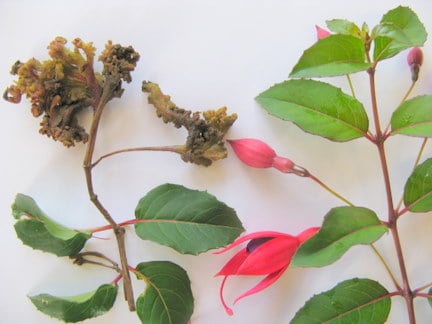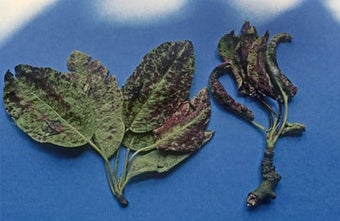
Quick facts
Common name - Fuchsia gall mite
Scientific name - Aculops fuchsiae
Plants affected - Garden and greenhouse fuchsias
Main symptoms - Growth at the shoot tips is swollen and distorted, often with a yellowish green or reddish discolouration. Flowers are deformed or fail to develop
Most active - May to September
What is fuchsia gall mite?
Fuchsia gall mite is a microscopic -sucking mite that is specific to fuchsias. It can cause extensive galling and distortion affecting the appearance of fuchsias.
Gall mites are tiny sap-sucking creatures that can cause a variety of abnormal growths on various plants. Although too small to be seen without a microscope, the galled tissues that they create are often very distinctive and easily recognised. Most gall mites are harmless and are part of the a healthy garden can support. More information on some of these gall mites can be found here. Unfortunately the distortion caused by fuchsia gall mite can be severe and affect flowering.
Symptoms
Signs of fuchsia gall mite:
- Fuchsia gall mite is a microscopic creature that can have a profound effect on the growth of fuchsia plants
- The mites are 0.25 mm long, too small to be seen without a microscope
- They affect new growth at the shoot tips where they suck and secrete chemicals that prevent the normal development of leaves and flowers
- As the numbers of mites rise, foliage becomes increasingly distorted until plants no longer produce normal leaves or flower
- Growth at the shoot tips consists of a mass of yellowish green or reddish-pink distorted tissue instead of leaves or flower buds
Management
- Cutting off affected shoot tips will remove many mites but regrowth is likely to become re-affected Affected material can be disposed of in council waste or buried to reduce likelihood of spreading the mite
- In California, it has been noted that although all fuchsias can host the mite, species and cultivars vary in susceptibility. The most susceptible species include Fuchsia arborescens, F. magellanica and F. procumbens
- Species and cultivars noted as being less susceptible, and which are listed in RHS Find a Plant as being available from one or more UK suppliers, are 'Baby Chang', 'Cinnabarina', 'Miniature Jewels', 'Space Shuttle', Fuchsiamicrophylla subsp. hidalgensis, Fuchsia thymifolia and Fuchsia venusta
- A predatory mite (Amblyseius andersoni) is sold as a biological control of the mite (see Biological control suppliers). The suppliers advise that if you have had the mite in previous years, or if your plants are already infected, then affected growth should be cut out to at least 10 cm below any galls or distorted tissue. Then introduce the predator to prevent the mite causing damage to regrowth
Download
Biological control suppliers (downloads pdf document)
Biology
Fuchsia gall mite was first discovered in Brazil in the late 1970s. It has since spread elsewhere, including California, France, Germany and the Channel Islands. The mite was first found on the mainland of Britain in September 2007 when samples of affected fuchsias were sent to RHS Gardening Advice. These affected plants were previously healthy hardy fuchsias that had been growing in a private garden near Fareham, Hants, for about 20 years. Subsequently the mite has been found in other gardens across southern England and reported from Wales. It was found in south Wales and Cheshire for the first time in 2017.
The gall mite may have been introduced to the UK by the nursery trade on imported pot plants, or it could have arrived on collected by someone who had visited the Channel Islands or Brittany, France, where the mite is widespread. Being tiny animals, gall mites cannot travel far by their own means, but, while crawling around, can get blown by the wind to another plant. They can also hitch a ride on insects and other animals that alight on affected fuchsias.
The mite has several generations between late spring to autumn and it takes about 21 days to complete the life cycle at 18°C (64°F). The mites overwinter under scales but may remain active during the winter on glasshouse fuchsias. The mites cold tolerance is not well studied but it may not survive temperatures below 5°C (41°F). Therefore cold winters may kill it on hardy garden fuchsias.
RHS and Fera entomologists produced a scientific paper on the mite in 2014 - see RHS entomology publications






